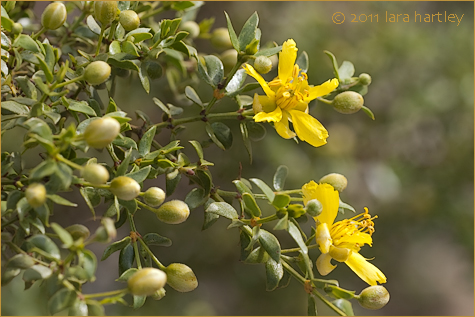Creosote Bush
Larrea tridentata

Color: Yellow
Common name: Creosote Bush, Greasewood
Latin name: Larrea tridentata
Family: ZYGOPHYLLACEAE
Height: 3-10 feet

Description: Creosote bush is an open, vase-shape shrub with solitary, small, numerous flowers on grayish stems/trunks.
Leaf: The leaf is a distinctive bifolate wing, tiny; usually yellow-green becoming darker and aromatic after rainfall.
Range: Desert, East of Sierra Nevada, (uncommon in Tehachapi Mountain Area, San Joaquin Valley, South Coast, San Jacinto Mountains)
Habitat: Common. Desert scrub
Elevation: < 1000 m.
Flowering time: Blooms mainly in spring, sporadically throughout the year.
Notes: Greasewood has a distinctive odor after rainfall, the characteristic southwest desert smell. It is not the source of commercial creosote. It is an excellent indicator plant (size indicates amount of water naturally present, or if stunted may indicate presence of caliche.) Even though the creosote bush is touted as a herbal remedy for many maladies, the FDA has issued warnings about the health hazards of ingesting creosote bush or using it as an internal medicine and discourages its use. Creosote bush is difficult to salvage from the wild, the root ball must be kept intact with best success after fall or winter rain. Clones may live 10,000 years, longer than any other living plants known.
HORTICULTURAL:
- Exposure: full sun, reflected heat
- Water: natural rainfall; some supplemental while establishing
- Soil: tolerant
- Propagation: seed, difficult to transplant
- Maintenance: minimal

Read more about the Creosote Bush.
We have an online wildflower field guide that is designed to help you identify desert wildflowers by color, scientific name, region and common name. The pictures are sized to work on the iPod, iPhone, iPad and similar devices. With your iPod or phone you will easily be able to identify wildflowers while in the desert. Links for downloads are on the bottom of the Wildflower Field Guide page.
Photo tips: Most digital point-and-shoot cameras have a macro function - usually symbolized by the icon of a little flower. When you turn on that function, you allow your camera to get closer to the subject, looking into a flower for example. Or getting up close and personal with a bug. More on desert photography.
Mojave Desert Wildflowers - This book is the standard by which all other wildflower books are measured. The author, Jon Mark Stewart, has combined super photography with concise information. This book has an entire color page for each wildflower covered, with a discussion of the wildflower. 210 pages with 200 color photos. More...
What's Blooming Now - Check the Wildflower Reports
Related DesertUSA Pages
- How to Turn Your Smartphone into a Survival Tool
- 26 Tips for Surviving in the Desert
- Death by GPS
- 7 Smartphone Apps to Improve Your Camping Experience
- Maps Parks and More
- Desert Survival Skills
- How to Keep Ice Cold in the Desert
- Desert Rocks, Minerals & Geology Index
- Preparing an Emergency Survival Kit
- Get the Best Hotel and Motel Rates
Share this page on Facebook:
DesertUSA Newsletter -- We send articles on hiking, camping and places to explore, as well as animals, wildflower reports, plant information and much more. Sign up below or read more about the DesertUSA newsletter here. (It's Free.)
The Desert Environment
The North American Deserts
Desert Geological Terms

